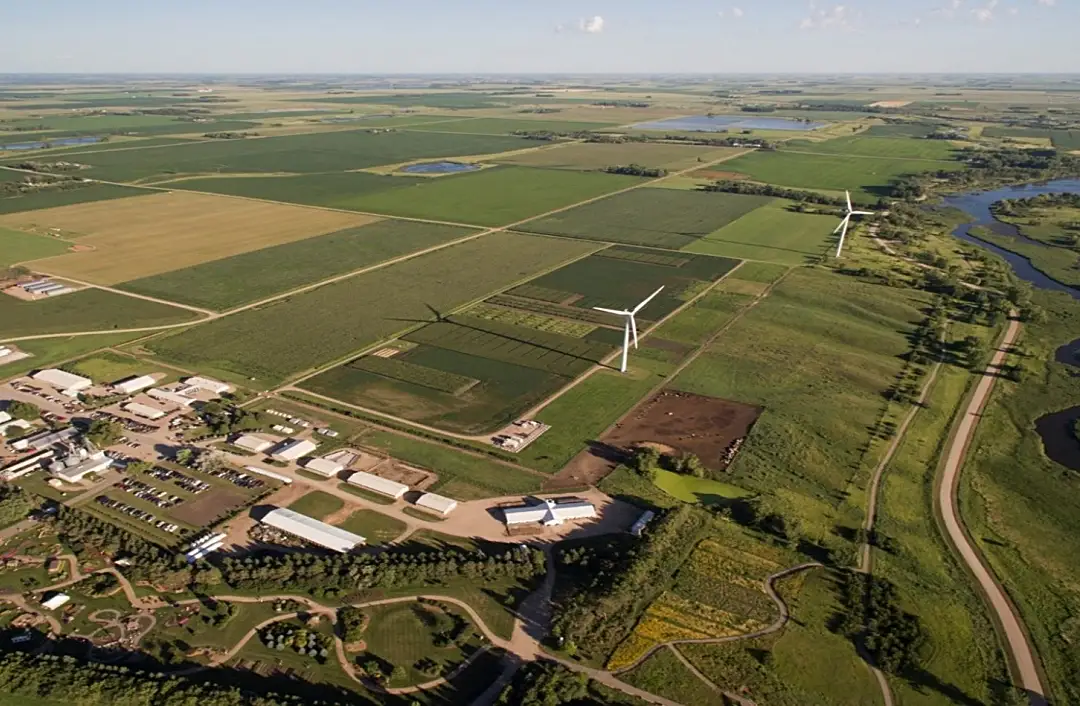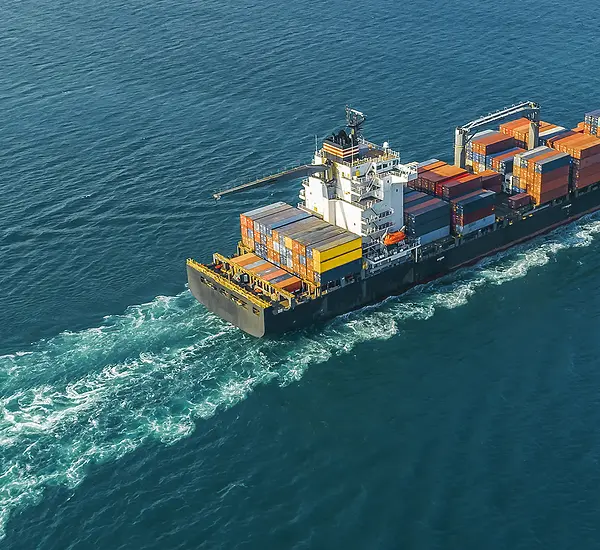
Image courtesy of the University of Minnesota’s West Central Research and Outreach Center.
Imagine using ammonia, manufactured cleanly using renewable energy, to run ships and machinery, produce fertilizer, support renewable power production, and serve many other useful applications.
As fantastic as it sounds, “green ammonia” is not just an engineer’s pipe dream. With the advent of new technologies, it is attracting extensive global attention and new R&D funding. This makes us cautiously optimistic that green ammonia could play a key role in both clean energy storage and decarbonizing the world’s most challenging market sectors, including shipping and agriculture.
While green ammonia alone won’t mitigate all those emissions, its versatility as a source for marine fuel, fertilizer production, and even electrical power generation can make it impactful. And since ammonia is one of the most widely produced industrial chemicals in the world, significant infrastructure is already in place to store and move it. In fact, even the ships used to transport ammonia could be powered by this green fuel.
The objectives now are to bring down production and utilization costs, fully assess the benefits, risks, and potential impacts of green ammonia and pursue real world demonstrations that explore its viability as a strategy that not only reduces GHG emissions but is cost competitive with fossil fuels.

Renewable Ammonia Production and Use
The U.S. Department of Energy’s Advanced Research Project Agency-Energy (ARPA-E) has funded RTI's exploration of next-generation processes for producing and using ammonia. The project has received strong industry and university backing. In addition to RTI, Casale, University of Minnesota, and Nutrien, the project team includes GE, Nel Hydrogen, Xcel Energy, Great River Energy, Otter Tail Power Company, Runestone Electric Association, Chemtronergy, Texas Tech University, Pacifica, the Agricultural Utilization Research Institute (AURI) and Shell.
Greening the production of ammonia
The current method of manufacturing ammonia is anything but green. It consumes a lot of energy derived from burning fossil fuels and it emits carbon dioxide, contributing to global warming. To produce ammonia, methane—the primary component of natural gas—is heated with steam and a catalyst to produce a mixture of carbon monoxide and hydrogen. This process, known as steam methane reforming (SMR), accounts for about 90 percent of the carbon dioxide (CO2) generated during manufacturing. The hydrogen is then mixed with nitrogen at elevated temperature and pressure and converted to ammonia in the Haber-Bosch process. About 85 percent of the ammonia produced globally today is used to make fertilizer, generating approximately 500 million tons of CO2 each year in the process.
To reduce the carbon footprint of ammonia production, the SMR process is replaced with electrolysis, which uses electricity to split water into oxygen and hydrogen. If the electricity is generated from renewable sources, such as wind and solar, the resulting hydrogen is also considered renewable and CO2-free.
Green ammonia can integrate renewables into the grid
Besides reducing the carbon footprint of manufacturing fertilizer, green ammonia can play a critical role in expanding the use of renewables by better integrating them into the existing electrical grid. Though solar and wind can generate significant amounts of power, these sources are intermittent. The grid demands a consistent base supply supplemented with peaking sources, so utilities currently use natural gas to balance the contribution of renewables. If we’re truly serious about decarbonizing, we must wean ourselves off fossil fuels and deal with this challenge of variable production through efficient energy storage systems.
Energy can be stored in a variety of ways depending on location and application. Pumped-hydro requires a specific type of geology. Battery grids work well, but they are cost-effective only for short-term storage. Chemicals like ammonia and hydrogen could be better for long-term storage. Green ammonia could be used like a giant battery to store energy and can be easily transported to distinct locations for emergency needs and to meet peak power demands.
Innovative applications for green ammonia
Having something like ammonia, which can be liquified for easy transport, makes a lot of sense for the transportation sector because it can also be used to make a carbon-free fuel and power source. The maritime shipping industry is already adopting it as fuel and some companies have begun developing ammonia-fueled engines. We’re also finding that farmers can use ammonia to reduce fossil fuels in their operations, such as replacing the propane that runs grain dryers, and we’re working with start-ups that are developing ammonia-powered trucks and direct ammonia fuel cells to generate power. We’ll be considering all these potential uses through our market studies.
Real world demonstration of green ammonia technologies
RTI is leading the development of new, integrated green ammonia technologies under a multi-phase program funded by the U.S. Department of Energy’s Advanced Research Projects Agency-Energy (ARPA-E), which shepherds high-impact energy technologies that show exciting potential but aren’t quite ready for private sector investment. We began with a proof-of-concept feasibility study in 2016, followed by small-scale system development between 2017 and 2020. We’re now leading a large, diverse team in a pilot scale real world demonstration at the University of Minnesota’s West Central Research and Outreach Center (WCROC) in Morris, MN.
We’ll be using renewable energy—we have access to more than 3.5 megawatts of electricity generated by a combination of wind and solar energy—to produce 1 metric ton per day of green ammonia. Our team’s innovation centers around a new energy-efficient process that, in comparison to the century-old Haber-Bosch process, allow us to operate at lower temperatures and pressure, with much more flexibility to respond to the intermittent availability of wind and solar. These innovations decrease the amount of hydrogen that needs to be stored on-site and reduce the cost of ammonia production by up to 45 percent.
In addition, we are also partnering with leading universities and industry collaborators to highlight innovative technologies to use ammonia. We will consider how we might retrofit existing gas turbines to burn ammonia for power, demonstrate a fuel cell that can use ammonia directly to produce power, and demonstrate an ammonia-powered forklift. Finally, because WCROC is an agricultural campus, we can demonstrate that the low- or zero-carbon ammonia we make in the pilot can be directly applied to agricultural fields.
Transitioning to green ammonia requires new investments—and the understanding of potential risks—for stakeholders, such as utilities and those who produce hydrogen and ammonia. This is an unfamiliar paradigm for these folks, and it is still unclear what role each of the stakeholders will play. We’ll be exploring that issue as part of our demonstration, which is one reason why we’ve included key stakeholders as partners in this project. We also want to increase their familiarity with the ammonia production process and involve them in assessing the full environmental impact of green ammonia while watching for unintended and unanticipated consequences.

Green Ammonia as a Sustainable Maritime Fuel
Part of our work on green ammonia involves connecting technology developers to end-users to accelerate commercialization. RTI Innovation Advisors is studying the market to find opportunities to deploy green ammonia fuel for maritime shipping decarbonization.
Technologies and smart policies can drive down production costs
The political will has never been stronger to advance alternative energy sources in the United States. The current development of green ammonia is driven by policies that offer incentives of more than $500 per ton. The recently adopted Bipartisan Infrastructure Law offers attractive incentives, but they’re only available for a decade. This creates an uncertain economic landscape for corporate investors because these capital projects can require hundreds of millions of dollars to put in place and typically do not conform to the 10-year period. We must be certain projects can stand on their own when the incentives run out and be economically viable and sustainable in the long run.
It's encouraging to see so much movement in this sector due to a fortuitous combination of political will and technological development. These innovative technologies can continue to reduce the cost of green ammonia. Though even then it won’t be cheaper than fossil fuels, we expect that green ammonia will eventually be competitive as technologies continue to improve and economies of scale come into play.
